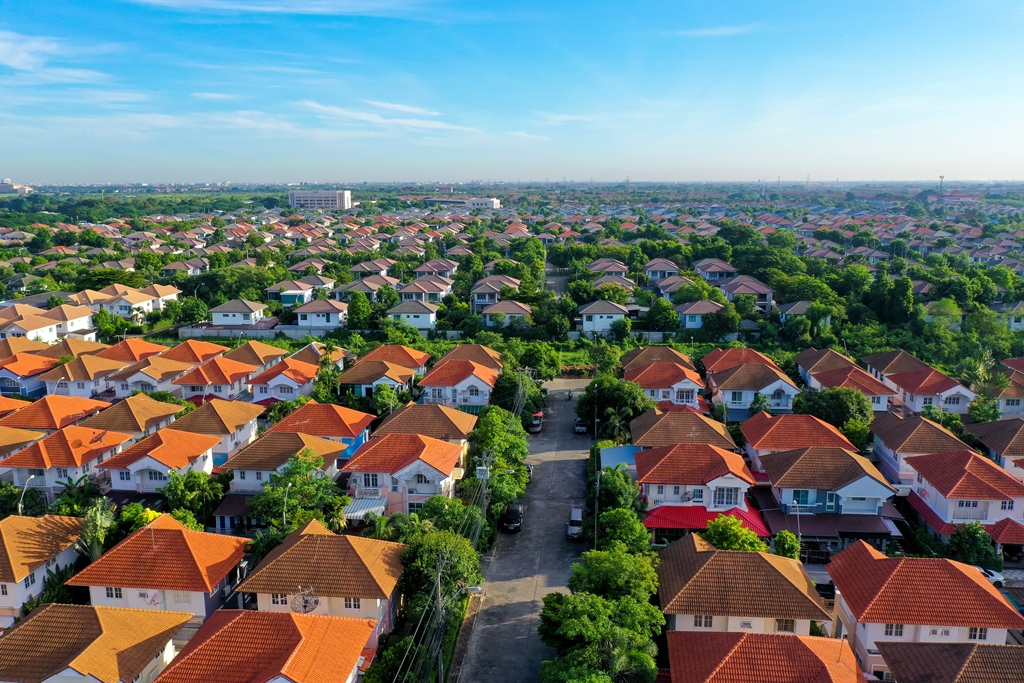Column EXPLAINER: How interest rates affect household debt
วันที่ : 9 พฤศจิกายน 2566
SOMRUEDI BANCHONGDUANG AND KANANA KATHARANGSIPORN
The BoT has several measures intended to ease elevated levels of indebtedness among Thai individuals
Elevated interest rates became the topic of public discussion recently after a homebuyer posted her home instalment payment of 10,900 baht on social media, of which the principal accounted for only five baht, while interest expense was 10,894.5 baht.
The post garnered much attention following interest rates hikes the past two years as mortgages with variable rates require higher interest payments, which could lead to more a fragile economy.
Household debt has swelled in the country and the Bank of Thailand plans to implement new household debt measures, effective from Jan 1, 2024.
According to central bank data, Thailand's household debt reached 16 trillion baht in the first quarter of this year, or 90.7% of the country's GDP, deteriorating from 87% recorded in the fourth quarter of 2022.
The ratio is higher than the Bank for International Settlements' (BIS) ceiling of 80%.
WHICH SECTORS ARE THE MAIN CONTRIBUTORS TO HOUSEHOLD DEBT?
The National Credit Bureau (NCB) reported total household debt of member financial institutions tallied 13.6 trillion baht in the third quarter of 2023, up 3.8% year-on-year and 0.7% quarter-on-quarter.
The household debt is mainly attributed to housing and auto loans worth 4.93 trillion baht and 2.61 trillion baht, respectively.
NCB chief executive Surapol Opasatien said rising non-performing loans (NPLs) and special mention (SM) loans among the housing and auto hire-purchase sector are a major concern as cost of living and interest rates increase, while the central bank's debt relief measures are due to expire at the end of this year.
NPLs of member financial institutions tallied 1.05 trillion baht in the third quarter of 2023, down by 3.6% from 1.09 trillion year-on-year, but up by 1.7% quarter-on-quarter.
Debt repayment of auto loans began to show negative signs from the first quarter, while NPLs of loan products have increased from the second quarter, said the NCB.
Despite the debt restructuring programme for auto loan borrowers offered by financial institutions, NPLs remained steady in the third quarter, said the bureau.
In the third quarter, the NPLs of auto loans totalled 207 billion baht, up 20.9% year-on-year and 5.8% quarter-on-quarter.
SM loans, defined as loans overdue from 30-90 days, tallied 493 billion baht in the third quarter, increasing 3.7% quarter-onquarter and 21.4% year-on-year.
SM loans specifically for auto loans amounted to 213 billion baht, down by 4% quarter-on-quarter, noted the NCB.
SM loans in the auto sector did not significantly decline under the debt restructuring programme and are likely to become NPLs, said the bureau.
HOW DOES RISING INTEREST RATES AFFECT THE PROPERTY SECTOR?
Increasing interest rates directly impact both the demand and supply sides of the property sector as it incurs higher financial costs for both.
For homebuyers, higher rates decrease their purchasing power and make monthly mortgage payments more expensive, leading to decreased demand for homes.
If a borrower wants to maintain the same instalment payment when rates rise, the principal amount is decreased in the payment. This can cause potential buyers to delay their purchases.
"Every one-percentage-point increase in interest rates results in homebuyers paying 7% more," said Kessara Thanyalakpark, managing director of SET-listed Sena Development.
She said the interest rate hikes weaken the purchasing power of homebuyers, making them more likely to opt for units at lower prices so they can afford the instalment payments.
In addition, higher interest rates trigger more mortgage rejections, with some developers reporting rejection rates as high as 50%.
Vichai Viratkapan, acting director-general of the Real Estate Information Center (REIC), said the five interest rate hikes from March to September this year prompted the housing market forecast to shift to the worst-case scenario.
"The effects of these hikes impact homebuyers across all price ranges, with a clearer impact on individuals with lower or middle income levels, potentially delaying their purchasing decisions," he said.
REIC forecast the total number of residential units transferred nationwide this year will decrease by 19.2% to 317,485 units, while the value would decline by 14.1% to 915 billion baht.
Slower purchases also reduces the amount of new residential supply launched, especially in the lower price range, as the existing inventory remains large, noted the centre.
For developers, higher rates increase development costs, particularly financial costs. Many developers shifted to debentures, which had lower costs, from last year to reduce their dependency on project finance.
An organisation representing developers suggested loan-to-value limits be relaxed after a previous incentive expired last year, in addition to asking the government to provide special interest rates for firsttime homebuyers.
WHAT IS THE MAJOR CAUSE OF HOUSEHOLD DEBT IN THAILAND?
There are multiple factors behind the swelling household debt, according to analysts.
Thailand had a prolonged period of ultralow interest rates, for roughly a decade, then faced financial vulnerabilities from investor's search-for-yield behaviour, which led to higher debts.
Financial institutions supported retail borrowing of all types, including housing, auto, personal and credit card loans.
Several recent governments also implemented populist policies, including special loan programmes and debt moratorium schemes.
The country's household debt increased significantly from 59.3% of GDP in 2010 to 89.7% in 2020, rising to 90.2% in 2021, which was mainly attributed to the impact of the pandemic.
"The pandemic's impact on income reduction played a role, but increased access to digital finance is also a contributing factor," said Somkiat Tangkitvanich, president of the Thailand Development Research Institute.
Households remain fragile because of high debt levels and a rising cost of living, especially low-income individuals and small and medium-sized enterprises (SMEs) in the tourism and service sectors.
The higher cost of living could erode debt repayment ability among fragile borrowers, while NPLs in the banking sector are expected to increase next year as the central bank's relief measures expire at the end of this year.
A household debt level exceeding 80% of GDP is more likely to impede long-term economic growth and could pose a risk to the country's financial stability, according to ratings agencies.
WHAT ARE THE CENTRAL BANK MEASURES INTENDED TO EASE THE HOUSEHOLD DEBT PROBLEM?
The central bank is scheduled to implement responsible lending (RL) guidelines from Jan 1, 2024 in an effort to reduce the country's household debt.
Under the RL approach, the central bank requires financial institutions to offer consumer loans with responsibility, reasonability, fair prices, and in line with debtors' repayment capabilities, said Suwannee Jatsadasak, assistant governor for the supervision group at the Bank of Thailand.
The guidelines call for financial institutions to provide debt restructuring (DR) for retail debtors and SME debtors that are not classified as NPLs.
For NPLs, the central bank requires financial institutions provide troubled debt restructuring (TRD), defined as restructuring in which a creditor grants a concession to a debtor that it would not normally consider prior to NPL sales or entering into the legal process.
Enforcement of both the DR and TRD regulations take effect from January 2024.
The guidelines also cover advertising and selling debts, particularly for new loan offerings starting from 2024.
The regulator prohibits ad and marketing campaigns that may encourage excessive borrowing or discourage a healthy credit culture, including terms such as "instant loan" or "no collateral needed" without clear explanations about how the interest and principal are computed or deducted from each payment.
As part of the measures, the central bank plans to assist low-income debtors with persistent debt (PD) and revolving personal loans to fully repay their loans within five years at an interest rate of 15% per year or less. The maximum interest rate for personal loan products is 25%.
The central bank is scheduled to enforce the new PD measures from April 1, 2024.
"The lower interest rate should attract borrowers who have been indebted for a long time to join the programme, which enables them to exit from the debt cycle faster," said Ms Suwannee.
The regulator divides PD borrowers into two groups: general and severe. General PD borrowers have been indebted for three consecutive years, while severe PD borrowers have been indebted for five consecutive years and have a minimum monthly income of 20,000 baht at banks, or 10,000 baht at non-bank institutions.
The central bank also implemented riskbased pricing measures allowing financial institutions to charge interest rates for new retail loans based on the risk profile of the borrower. The regulator did not stipulate a ceiling interest rate for this approach.
The bank also implemented a debt service ratio (DSR) to contain household debt. Initially the regulator set the DSR for individual borrowers with a monthly income of less than 30,000 baht at 60% of the total loan outstanding, and 70% for borrowers with minimum income of more than 30,000 baht per month.
"The central bank will continue rolling out measures to curb rising household debt in the long term. It will not be easy to reduce the household debt-to-GDP ratio to 80% in the short term, but we will attempt to gradually reduce the ratio to be in line with the BIS standard," she said.
WHAT IS THE AVERAGE DEBT OBLIGATION FOR A THAI?
According to a survey by the central bank's Puey Ungphakorn Institute for Economic Research (PIER) in March 2022, the debt burden started early for many Thais and the level maintained even as they approach retirement.
Some 24% of people surveyed aged 20-35 are in debt, while 20% of those aged 36-60 are indebted and 11% of people older than 60.
In 2022, 37% of the country's total population was indebted, up from 30% in 2017.
Some 57% of individuals have debts exceeding 100,000 baht, while 14% have debts exceeding 1 million baht, noted the survey.
The average debt per person in Thailand works out to 520,000 baht, most of which are agricultural loans accumulated through the long-term debt moratorium, said PIER.
Household debt has almost doubled in the last 10 years.
According to BIS's data, Thailand's household debt-to-GDP ratio in 2021 was 90%, far above its pre-pandemic level and the highest level among developing countries.
The household debt-to-GDP ratio of Malaysia was 73.1%, Japan 67.6%, China 61.6%, Singapore 58.3%, India 37.1% and Indonesia 17.3%.
Thailand's household debt ratio was closer to developed economies, as the US tallied a household debt-to-GDP ratio of 78% and the UK 86.4%.
"Special mention loans in the auto sector did not significantly decline under the debt restructuring programme and are likely to become NPLs. NATIONAL CREDIT BUREAU
The BoT has several measures intended to ease elevated levels of indebtedness among Thai individuals
Elevated interest rates became the topic of public discussion recently after a homebuyer posted her home instalment payment of 10,900 baht on social media, of which the principal accounted for only five baht, while interest expense was 10,894.5 baht.
The post garnered much attention following interest rates hikes the past two years as mortgages with variable rates require higher interest payments, which could lead to more a fragile economy.
Household debt has swelled in the country and the Bank of Thailand plans to implement new household debt measures, effective from Jan 1, 2024.
According to central bank data, Thailand's household debt reached 16 trillion baht in the first quarter of this year, or 90.7% of the country's GDP, deteriorating from 87% recorded in the fourth quarter of 2022.
The ratio is higher than the Bank for International Settlements' (BIS) ceiling of 80%.
WHICH SECTORS ARE THE MAIN CONTRIBUTORS TO HOUSEHOLD DEBT?
The National Credit Bureau (NCB) reported total household debt of member financial institutions tallied 13.6 trillion baht in the third quarter of 2023, up 3.8% year-on-year and 0.7% quarter-on-quarter.
The household debt is mainly attributed to housing and auto loans worth 4.93 trillion baht and 2.61 trillion baht, respectively.
NCB chief executive Surapol Opasatien said rising non-performing loans (NPLs) and special mention (SM) loans among the housing and auto hire-purchase sector are a major concern as cost of living and interest rates increase, while the central bank's debt relief measures are due to expire at the end of this year.
NPLs of member financial institutions tallied 1.05 trillion baht in the third quarter of 2023, down by 3.6% from 1.09 trillion year-on-year, but up by 1.7% quarter-on-quarter.
Debt repayment of auto loans began to show negative signs from the first quarter, while NPLs of loan products have increased from the second quarter, said the NCB.
Despite the debt restructuring programme for auto loan borrowers offered by financial institutions, NPLs remained steady in the third quarter, said the bureau.
In the third quarter, the NPLs of auto loans totalled 207 billion baht, up 20.9% year-on-year and 5.8% quarter-on-quarter.
SM loans, defined as loans overdue from 30-90 days, tallied 493 billion baht in the third quarter, increasing 3.7% quarter-onquarter and 21.4% year-on-year.
SM loans specifically for auto loans amounted to 213 billion baht, down by 4% quarter-on-quarter, noted the NCB.
SM loans in the auto sector did not significantly decline under the debt restructuring programme and are likely to become NPLs, said the bureau.
HOW DOES RISING INTEREST RATES AFFECT THE PROPERTY SECTOR?
Increasing interest rates directly impact both the demand and supply sides of the property sector as it incurs higher financial costs for both.
For homebuyers, higher rates decrease their purchasing power and make monthly mortgage payments more expensive, leading to decreased demand for homes.
If a borrower wants to maintain the same instalment payment when rates rise, the principal amount is decreased in the payment. This can cause potential buyers to delay their purchases.
"Every one-percentage-point increase in interest rates results in homebuyers paying 7% more," said Kessara Thanyalakpark, managing director of SET-listed Sena Development.
She said the interest rate hikes weaken the purchasing power of homebuyers, making them more likely to opt for units at lower prices so they can afford the instalment payments.
In addition, higher interest rates trigger more mortgage rejections, with some developers reporting rejection rates as high as 50%.
Vichai Viratkapan, acting director-general of the Real Estate Information Center (REIC), said the five interest rate hikes from March to September this year prompted the housing market forecast to shift to the worst-case scenario.
"The effects of these hikes impact homebuyers across all price ranges, with a clearer impact on individuals with lower or middle income levels, potentially delaying their purchasing decisions," he said.
REIC forecast the total number of residential units transferred nationwide this year will decrease by 19.2% to 317,485 units, while the value would decline by 14.1% to 915 billion baht.
Slower purchases also reduces the amount of new residential supply launched, especially in the lower price range, as the existing inventory remains large, noted the centre.
For developers, higher rates increase development costs, particularly financial costs. Many developers shifted to debentures, which had lower costs, from last year to reduce their dependency on project finance.
An organisation representing developers suggested loan-to-value limits be relaxed after a previous incentive expired last year, in addition to asking the government to provide special interest rates for firsttime homebuyers.
WHAT IS THE MAJOR CAUSE OF HOUSEHOLD DEBT IN THAILAND?
There are multiple factors behind the swelling household debt, according to analysts.
Thailand had a prolonged period of ultralow interest rates, for roughly a decade, then faced financial vulnerabilities from investor's search-for-yield behaviour, which led to higher debts.
Financial institutions supported retail borrowing of all types, including housing, auto, personal and credit card loans.
Several recent governments also implemented populist policies, including special loan programmes and debt moratorium schemes.
The country's household debt increased significantly from 59.3% of GDP in 2010 to 89.7% in 2020, rising to 90.2% in 2021, which was mainly attributed to the impact of the pandemic.
"The pandemic's impact on income reduction played a role, but increased access to digital finance is also a contributing factor," said Somkiat Tangkitvanich, president of the Thailand Development Research Institute.
Households remain fragile because of high debt levels and a rising cost of living, especially low-income individuals and small and medium-sized enterprises (SMEs) in the tourism and service sectors.
The higher cost of living could erode debt repayment ability among fragile borrowers, while NPLs in the banking sector are expected to increase next year as the central bank's relief measures expire at the end of this year.
A household debt level exceeding 80% of GDP is more likely to impede long-term economic growth and could pose a risk to the country's financial stability, according to ratings agencies.
WHAT ARE THE CENTRAL BANK MEASURES INTENDED TO EASE THE HOUSEHOLD DEBT PROBLEM?
The central bank is scheduled to implement responsible lending (RL) guidelines from Jan 1, 2024 in an effort to reduce the country's household debt.
Under the RL approach, the central bank requires financial institutions to offer consumer loans with responsibility, reasonability, fair prices, and in line with debtors' repayment capabilities, said Suwannee Jatsadasak, assistant governor for the supervision group at the Bank of Thailand.
The guidelines call for financial institutions to provide debt restructuring (DR) for retail debtors and SME debtors that are not classified as NPLs.
For NPLs, the central bank requires financial institutions provide troubled debt restructuring (TRD), defined as restructuring in which a creditor grants a concession to a debtor that it would not normally consider prior to NPL sales or entering into the legal process.
Enforcement of both the DR and TRD regulations take effect from January 2024.
The guidelines also cover advertising and selling debts, particularly for new loan offerings starting from 2024.
The regulator prohibits ad and marketing campaigns that may encourage excessive borrowing or discourage a healthy credit culture, including terms such as "instant loan" or "no collateral needed" without clear explanations about how the interest and principal are computed or deducted from each payment.
As part of the measures, the central bank plans to assist low-income debtors with persistent debt (PD) and revolving personal loans to fully repay their loans within five years at an interest rate of 15% per year or less. The maximum interest rate for personal loan products is 25%.
The central bank is scheduled to enforce the new PD measures from April 1, 2024.
"The lower interest rate should attract borrowers who have been indebted for a long time to join the programme, which enables them to exit from the debt cycle faster," said Ms Suwannee.
The regulator divides PD borrowers into two groups: general and severe. General PD borrowers have been indebted for three consecutive years, while severe PD borrowers have been indebted for five consecutive years and have a minimum monthly income of 20,000 baht at banks, or 10,000 baht at non-bank institutions.
The central bank also implemented riskbased pricing measures allowing financial institutions to charge interest rates for new retail loans based on the risk profile of the borrower. The regulator did not stipulate a ceiling interest rate for this approach.
The bank also implemented a debt service ratio (DSR) to contain household debt. Initially the regulator set the DSR for individual borrowers with a monthly income of less than 30,000 baht at 60% of the total loan outstanding, and 70% for borrowers with minimum income of more than 30,000 baht per month.
"The central bank will continue rolling out measures to curb rising household debt in the long term. It will not be easy to reduce the household debt-to-GDP ratio to 80% in the short term, but we will attempt to gradually reduce the ratio to be in line with the BIS standard," she said.
WHAT IS THE AVERAGE DEBT OBLIGATION FOR A THAI?
According to a survey by the central bank's Puey Ungphakorn Institute for Economic Research (PIER) in March 2022, the debt burden started early for many Thais and the level maintained even as they approach retirement.
Some 24% of people surveyed aged 20-35 are in debt, while 20% of those aged 36-60 are indebted and 11% of people older than 60.
In 2022, 37% of the country's total population was indebted, up from 30% in 2017.
Some 57% of individuals have debts exceeding 100,000 baht, while 14% have debts exceeding 1 million baht, noted the survey.
The average debt per person in Thailand works out to 520,000 baht, most of which are agricultural loans accumulated through the long-term debt moratorium, said PIER.
Household debt has almost doubled in the last 10 years.
According to BIS's data, Thailand's household debt-to-GDP ratio in 2021 was 90%, far above its pre-pandemic level and the highest level among developing countries.
The household debt-to-GDP ratio of Malaysia was 73.1%, Japan 67.6%, China 61.6%, Singapore 58.3%, India 37.1% and Indonesia 17.3%.
Thailand's household debt ratio was closer to developed economies, as the US tallied a household debt-to-GDP ratio of 78% and the UK 86.4%.
"Special mention loans in the auto sector did not significantly decline under the debt restructuring programme and are likely to become NPLs. NATIONAL CREDIT BUREAU
NEWS_EN อื่นๆ







